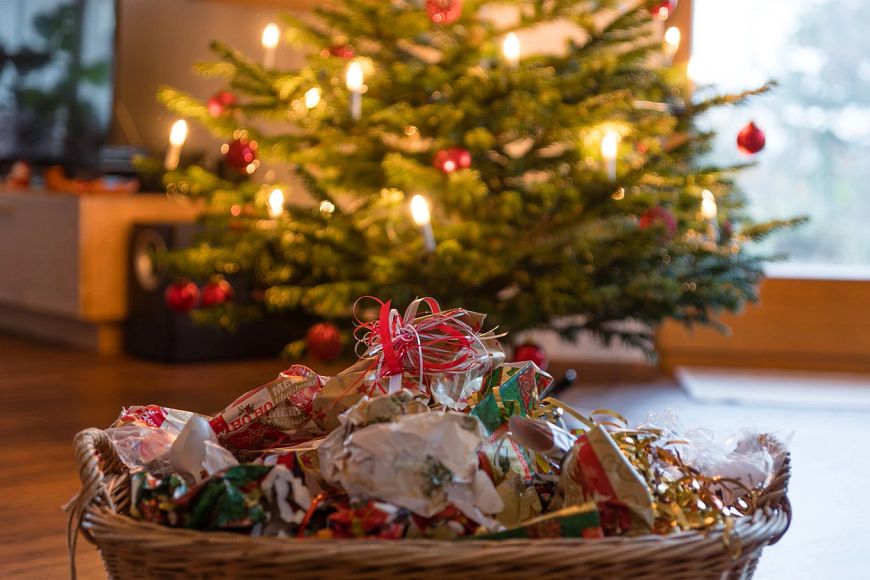Contact: Jennifer Semrau, DNR Waste Diversion and Recycling Coordinator
Jennifer.Semrau@wisconsin.gov or 608-381-0960
DNR Offers Tips On Reducing, Reusing And Recycling Waste This Holiday Season
 Wrapping paper that doesn't have any glitter, foil or other adornments can be recycled in most programs in Wisconsin.
Photo credit: iStock/SKatzenberger
Wrapping paper that doesn't have any glitter, foil or other adornments can be recycled in most programs in Wisconsin.
Photo credit: iStock/SKatzenberger
MADISON, Wis. – The Wisconsin Department of Natural Resources (DNR) encourages the public to recycle and reduce waste during the holiday season.
What Should Go In Your Recycling Bin
Many items can be recycled anywhere in Wisconsin. These items, which the state bans from landfills, include:
- Cardboard – Flatten boxes before putting them in carts or bins so that recycling equipment can handle them properly
- Newspaper
- Magazines
- Office paper
- Plastic #1 and #2 containers
- Aluminum cans
- Steel (tin) cans
- Glass bottles and jars
Wrapping paper that can be torn and doesn't have any glitter, foil or other adornments can be recycled in the majority of programs in Wisconsin.
Be sure the items are empty of any liquids and excess gunk, but you don't need to wash them with soap or put them through the dishwasher. For cans or bottles going into a curbside recycling cart or container, don't crush or flatten them – this makes it harder for equipment at recycling facilities to recognize and properly sort things like aluminum cans.
Most communities include junk mail and other mixed paper, such as cereal boxes. Check locally for a complete list, and don't rely on packaging labels. Keep in mind that what you can recycle at a relative's home may be different than what you can recycle at your own.
What Should Not Go In Your Recycling Bin
Some items can cause serious problems at recycling facilities that aren't designed to handle them, including a risk of fire and worker injury. Many of these can be recycled at drop-off sites but should not go in curbside recycling bins or carts. These include:
- Tissue paper
- Holiday light strings, cords and other "tanglers"
- At modern recycling facilities, these get wrapped around equipment, meaning a facility has to be shut down for workers to cut the material loose. Some retailers, electronics recyclers and communities offer seasonal recycling programs for light strings. If that's not an option, put broken lights in the trash.
- Plastic bags, plastic film and wrap
- These also get tangled in recycling equipment. Bagged recyclables also cause problems because workers can't be sure what's inside. Empty cans, bottles and other recyclables into your bin or cart, then put the bag in the trash. You can take many types of clean, dry plastic bags and wrap to store drop-off locations. Learn more about reducing, reusing and recycling plastic bags and wrap on the DNR's recycling plastic bags webpage.
- Batteries and electronics
- Recycling facilities that manage cans, bottles and cardboard and waste facilities that manage household garbage aren't set up to handle batteries and electronics. Rechargeable batteries cause fires in collection trucks and facilities if they are damaged by equipment, and many electronics contain hazardous materials. Find more information on how to recycle batteries and electronics, including drop-off site locations, on the DNR's electronics recycling webpage.
For more information about what can and can't be recycled, visit the DNR's What to Recycle in Wisconsin webpage.
Save Money With Food Waste Prevention Tips
A 2020 study conducted by Penn State estimated households lose $1,866 a year on food that's thrown out.
Here are some tips to reduce and prevent food waste at home:
- Understand date labels and when food items are actually unsafe. Date labels are NOT regulated by the Food and Drug Administration (FDA) or any other federal agency. Manufacturers apply date labels at their own discretion, with the exception of infant formula products. The FDA advises consumers to examine foods to determine if the quality is sufficient for use. Relying on your eyes and an old-fashioned sniff test can be a better indicator of the suitability of food for your use and could help you avoid disposing of healthy and safe food. That jar of nutmeg from last year is most likely still good, so you might be able to avoid re-purchasing some special holiday food items.
- Shop with a plan and prepare for gatherings. Purchasing more food than what is needed often leads to more food waste. You can reduce this problem by taking inventory of what you already have, planning meals, making detailed shopping lists and finding options to buy in bulk.
- Store food to extend its life. Storing food in the best manner for that food type can go a long way to reducing food waste and saving the time and money associated with additional grocery store runs. Save the Food's Store It guide is an excellent tool for learning the detailed recommendations for food items you buy the most or have the most challenging time keeping fresh.
For more details and additional tips, visit the DNR's Reducing Food Waste at Home webpage.
Find more information on reducing household waste during the holidays on the DNR's Recycling and Waste reduction webpage.

